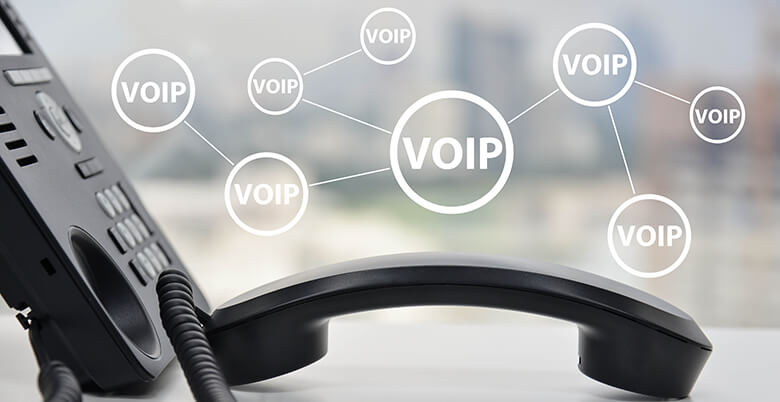Collaboration made easy with IP enabled Video Phones
A VoIP phone is a hardware- or software-based telephone designed to use voice over IP (VoIP) technology to send and receive phone calls over an IP network. The phone converts analog telephony audio into a digital format that can be transmitted over the internet and converts incoming digital phone signals from the internet to standard telephone audio.
VoIP phones, also known as IP phones, include features and capabilities not found in traditional analog phones. They also have additional performance requirements because phone calls are placed over the internet instead of the legacy public switched telephone network (PSTN).
How does a VoIP phone work?
Some VoIP phones require A/C adapters for power, while others use Power over Ethernet (PoE). PoE uses an Ethernet cable instead of an A/C adapter and removes the need for separate power and data cables.
Several networking components are required to make VoIP phones work. Phones are assigned IP addresses through the Dynamic Host Configuration Protocol (DHCP), which automatically configures the network and the VoIP parameters. A domain name system (DNS) tracks the IP addresses to enable devices, such as IP phones, to connect to each other.
VoIP phones require a number of protocols to facilitate the delivery of voice communications over the internet. H.323 is the most commonly used VoIP protocol that supports audio, video and data communications across IP networks. It provides several VoIP functions, including bandwidth management and call control.
Session initiation protocol (SIP) is a signaling protocol that sets up VoIP connections and is used as an alternative to H.323. Real-Time Transport Protocol (RTP) is used to send and receive multimedia information between two devices. VoIP services use RTP and SIP or H.323 to stream multimedia content. The Simple Traversal of UDP through NAT(STUN) protocol is used on some SIP-based VoIP phones to enable communications behind network firewalls, which can sometimes block SIP and RTP packets.
Some providers use their own proprietary protocols for VoIP phones. For example, the Skinny Client Control Protocol (SCCP) is a proprietary Cisco standard for communicating with H.323 VoIP systems.
Types of VoIP phones
The two main types of IP phones are hardware-based and software-based phones.
Physically, a hardware-based VoIP phone resembles a traditional hard-wired or cordless telephone. These phones include physical features such as a speakerphone or microphone, a touchpad, and display hardware to show user input and caller ID. VoIP phones also feature call transfer, multiparty calling and support for multiple VoIP accounts. Some VoIP phones can transmit and receive image data during calls, so they are considered video telephones.
Software-based IP phones, also known as softphones, are software clients installed on a user’s computer or mobile device. The softphone user interface often resembles a phone handset, with a touchpad and caller ID display. A headset with a microphone that connects to the computer or mobile device is encouraged, or sometimes required, to make calls. Users can also make calls using their device if it includes a built-in microphone
Softphone clients offer similar capabilities to hardware-based IP phones, such as voicemail, call conferencing and call transfer. Some clients may offer additional capabilities, such as video conferencing and instant messaging, however.
Traditional analog phones may also be converted into IP phones by connecting to an analog telephone adapter (ATA). Analog phones can be converted by plugging the Ethernet network jack into the ATA, which then connects to the phone. The analog phone will connect to the internet rather than the PSTN, and it will appear to the phone system as a VoIP phone.
Advantages and disadvantages of VoIP phones
- Organizations can reduce calling costs by switching to VoIP services. While traditional analog phones can have lower upfront costs, they are more costly to support, upgrade and integrate with communications applications. IP phones also offer cheaper long-distance and international calls, as VoIP phone calls are charged at the local rate of the call’s destination.
- VoIP phones offer greater mobility and scalability than traditional handsets. If an organization moves to a new location, it doesn’t need to acquire new phone lines, which it would with a traditional phone system. Adding new phones to a VoIP system is only limited by the available bandwidth on the organization’s network. Softphones also provide increased mobility, as the clients are not tied to physical locations like they would be with hard-wired phones.
- VoIP phones can also integrate with other communications applications. For example, organizations can integrate their customer relationship management (CRM) software with VoIP phones to enhance caller ID and keep records of call information.
- VoIP phones, however, do have disadvantages. For example, VoIP phones require a reliable internet connection and are susceptible to bandwidth constraints. With insufficient bandwidth, phone calls may experience latency, which can result in delays and dropped calls. Additionally, if an organization has a power or internet outage, users cannot make calls from their VoIP phones.
Source: www.techtarget.com




